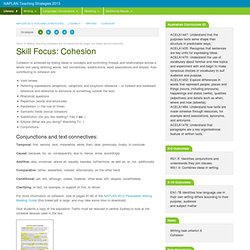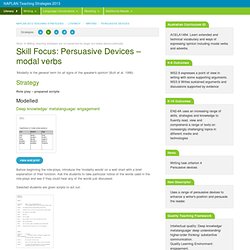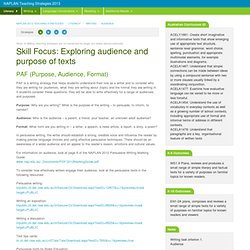

Pin bored game. KS2 Bitesize English - Punctuation : Play. NAPLAN Teaching Strategies 2013. (Note: In Writing, teaching strategies are not presented by stage, but simply alphanumerically) Reconstructing sentences from cut up sentence strips It is important to teach students what a sentence is so they can punctuate correctly and understand that punctuation helps us to read and make sense of what is written.

By breaking up sentences into single words and punctuation marks, students can reconstruct them in modelled, guided and independent activities. Explicitly teaching the metalanguage of sentences assists students to look for, be aware of and use punctuation markers in sentences. Opportunities to put elements together to form a coherent whole in contextual and meaningful activities should be provided so that students can practise, verbalise and transfer skills to new situations. Activities to support the strategy Guided Exploring metalanguage (QTF) Asking the students for suggestions and allowing them to manipulate the words to try their hypothesis is encouraged. Has to make sense. NAPLAN Teaching Strategies 2013. (Note: In Writing, teaching strategies are not presented by stage, but simply alphanumerically) A sentence is a group of words that makes complete sense and has a least one clause.

Sentences begin with a capital letter and they end with a full stop, a question mark or an exclamation mark. More complex sentences use sentence markers such as commas, dashes, semicolons and colons. Sentences can: Make statements (declaratives): The girl shot a goal. Most grammatical features within the sentence cluster around the noun and the verb. In NAPLAN Writing, sentences cannot be considered as grammatically correct if there is a lack of control of verb use - tense errors and subject-verb agreement errors - or preposition errors.
NAPLAN Teaching Strategies 2013. (Note: In Writing, teaching strategies are not presented by stage, but simply alphanumerically) A paragraph contains a group of connected sentences.

It is generally made up of one main idea and a number of supporting sentences. Paragraphs are the basic unit that segment longer pieces of writing, such as essays and reports. Paragraphs contain three main parts: A topic sentence, which contains the main idea of the paragraph. Pronouns Handout. NAPLAN Teaching Strategies 2013. (Note: In Writing, teaching strategies are not presented by stage, but simply alphanumerically) Cohesion is achieved by linking ideas or concepts and controlling threads and relationships across a whole text using referring words, text connectives, substitutions, word associations and ellipsis.

Also contributing to cohesion are: Verb tenses Referring expressions (anaphoric, cataphoric and exophoric reference – or forward and backward reference and reference to someone or something outside the text) Rhetorical questions Repetition (words and structures) Parallelism (+ the rule of three) Semantic fields (lexical cohesion) Substitution (Do you like reading? Moodle.lism.catholic.edu.au/pluginfile.php/11564/mod_resource/content/2/PETAA 192.pdf. Moodle.lism.catholic.edu.au/pluginfile.php/11561/mod_resource/content/2/writing resource book.pdf.
NAPLAN Teaching Strategies 2013. (Note: In Writing, teaching strategies are not presented by stage, but simply alphanumerically) Ethos: Ethos refers to the trustworthiness of the speaker/writer.

Ethos is an effective persuasive strategy because when we believe that the speaker does not intend to do us harm, we are more willing to listen to what s/he has to say. For example, when a trusted doctor gives you advice, you may not understand all of the medical reasoning behind the advice, but you nonetheless follow the directions because you believe that the doctor knows what s/he is talking about. This type of argument requires that you (the author) establish yourself as morally trustworthy and respectful of the audience.
You do this by demonstrating that you have evaluated your topic through research, which establishes your credibility and moral reasoning on the subject. Activities to support the strategy Modelled Since I feel that you are men of genuine good will and that your criticisms are sincerely set forth Guided. Moodle.lism.catholic.edu.au/pluginfile.php/11571/mod_resource/content/2/persuasive-writing-full-day_Lindsay Williams.pdf. Moodle.lism.catholic.edu.au/pluginfile.php/11570/mod_resource/content/3/Persuasive_Writing_Graphic_Organisers.pdf. NAPLAN Teaching Strategies 2013. (Note: In Writing, teaching strategies are not presented by stage, but simply alphanumerically) 'Modality is the general term for all signs of the speaker's opinion' (Butt et al. 1996) Role play – prepared scripts Modelled Deep knowledge/ metalanguage/ engagement Before beginning the role-plays, introduce the 'modality words' on a wall chart with a brief explanation of their function.

Selected students are given scripts to act out. After each performance, the class discussed the tactics used to persuade the characters and the language that was used. Guided Deep understanding/ higher-order thinking/substantive communication After the discussions, the students work in groups of three or four. The teacher is to facilitate and guide students. Independent Read and note the frequency of the modal words in an authentic text. Instruct student to rewrite the text by changing some of the modality from low/medium to high. Free Teaching Resources - Graphic Organizers. NAPLAN Teaching Strategies 2013. (Note: In Writing, teaching strategies are not presented by stage, but simply alphanumerically) The selection of a series of relevant ideas to support the thesis or argument and elaborating on them is an important part of persuasive writing.

To be highly persuasive, ideas should be elaborated by, for example, explaining cause and effect, presenting a range of issues both for and against the stated position, or refuting other positions. Consider the topic Everyone should learn to cook. Ask students to think about these questions: Should all people learn to cook? If students take this line of argument, they will have to define which groups do not need to learn to cook and give reasons why. Or do you agree that cooking is a useful skill for everyone to learn? The next step is to develop a list of reasons why learning to cook is a good idea. The Ideas worksheet may help them. Moodle.lism.catholic.edu.au/pluginfile.php/11636/mod_resource/content/2/Persuasive_Writing_Graphic_Organisers.pdf.
Brisbaneshs.eq.edu.au/sites/default/files/bshs/Curriculum/writing_guide.pdf. PEEL writing technique. NAPLAN Teaching Strategies 2013. (Note: In Writing, teaching strategies are not presented by stage, but simply alphanumerically) The introduction to a piece of persuasive writing should make the writer’s position or line of argument (thesis) clear.

It should also outline the arguments that the writer will cover in the body of the text. The introduction is the first part of the text that the reader sees, so it is important to make a good impression. A less developed introduction will simply contain the writer’s position on the topic, with little or no elaboration. For more information on introductions, look at pages 84-85 of the NAPLAN 2012 Persuasive Writing Marking Guide (this linked pdf file is large, and may take some time to download).
Consider the following examples and ask students to discuss how appropriate they are as the introduction to a piece of persuasive writing. NAPLAN Teaching Strategies 2013. (Note: In Writing, teaching strategies are not presented by stage, but simply alphanumerically) PAF is a writing strategy that helps students understand their role as a writer and to consider who they are writing for (audience), what they are writing about (topic) and the format they are writing in.

If students consider these questions, they will be able to write effectively for a range of audiences and purposes. Purpose: Why are you writing? What is the purpose of the writing – to persuade, to inform, to narrate? Audience: Who is the audience – a parent, a friend, your teacher, an unknown adult audience? Format: What form are you writing in – a letter, a speech, a news article, a report, a story, a poem? In persuasive writing, the writer should establish a strong, credible voice and influence the reader by making precise language choices and using effective persuasive techniques.
Moodle.lism.catholic.edu.au/pluginfile.php/11584/mod_resource/content/2/Australian Curriculum.pdf. Www.nap.edu.au/verve/_resources/Amended_2013_Persuasive_Writing_Marking_Guide_-With_cover.pdf. Minimum Standards - Writing. Writing | Year 3 | Year 5 | Year 7 | Year 9 | The NAPLAN writing task requires students to write in response to a stimulus or prompt.

The text of the prompt is read to all students. Between 2008 and 2010, the task was a narrative assessed against 10 criteria: Audience, Text Structure, Ideas, Character and Setting, Vocabulary, Cohesion, Paragraphing, Sentence Structure, Punctuation and Spelling. Each criterion has a different number of broad categories based on identifiable developmental stages.
From 2011, the NAPLAN Writing task has required students to respond to a stimulus with a piece of persuasive writing. Comparability of skills demonstrated in the Writing and Language Conventions assessments Spelling results, in particular, may not be comparable across the two assessment tasks. In the Writing tests, the Spelling criterion consists of six broad categories to measure the range of performance demonstrated from Year 3 through to Year 9. top^ Year 3 Year 5 Year 7 Year 9.